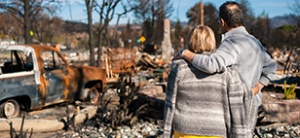With 33 lives lost, more than 11 million hectares of land burnt, and more than 2,000 homes destroyed, the Australian 2019–2020 bushfire crisis calls for Australian strata property owners to ask: is my strata property covered and prepared for a bushfire and fire damage?
For people living within dense urban areas, like Melbourne or Sydney’s CBD, there is little concern for whether one is covered for bushfire loss and damage. Given this only accounts for 1.9% of Australia’s population, there remains a widespread need for people to review their insurance covers. As being certain of what our insurance covers us for, can often be something we stick our heads in the sand over.
With volatile weather patterns on the rise, and more and more Australians living in fire-prone areas, we have asked CHU’s Chief Customer Officer, Anne-Maree Paull, to iron out what those living in residential strata and community living settings should know.
From a common property perspective, it’s checking the sum insured
It is mandatory for strata properties in Australia to have strata insurance. Regardless of your state and territory, legislation requires property owners to insure their building and common property and to have legal liability cover in place.
“As long as your owners corporation or body corporate has been keeping an active and compliant insurance policy, each strata property should be insured for things like walls, windows, lifts, driveways, gates, fences and pools from events such as fire, storm and water damage. Landscaping may also be covered under some policies. What’s important, however, is to check that your ‘sum insured’ is appropriate — this is the clincher.
“I recommend that property owners obtain a new valuation regularly and engage a suitably qualified expert to assess and value their building on a full replacement and reinstatement basis.
“The sum insured is the maximum amount your insurance company will pay in the event your property is destroyed or severely damaged. So, in the event of a bushfire, or in any case of a catastrophic event, it is worth making sure your building is insured for the full replacement, clean up, and reinstatement value. Some policies offer optional cover for the unexpected increase in the replacement cost of strata property following a loss in the event that a ‘catastrophe’ is declared by the Insurance Council of Australia.
“The important thing is to provide as much information about the building as possible, this will help achieve the best insurance outcome based on their specific circumstances. If there are issues raised in relation to fire protection, make sure your committee makes the relevant changes to establish or maintain adequate cover, which sometimes requires changing aspects of the property to make it more resilient to fire damage,” says Anne-Maree.
Maintain your property and follow the mandatory fire regulations that apply to your building
In order to minimise the impacts of a bushfire and — if something bad does happen — to help your claims process go as smoothly as possible, make sure your property and committee are proactive in looking after your property.
“There are some simple steps strata properties can take to minimise the risk of fire damaging their property, such as regular maintenance and removing fuel and vegetation from the roof, gutters, and the perimeter of the property,” says Anne-Maree.
Your home and contents
If a bushfire or major storm is threatening to damage or destroy your building or common property, there’s a good chance that your belongings and home are at risk too. According to Anne-Maree, it is crucial that individuals are adequately covered across each aspect of the building, both common property and personal possessions within the home where private belongings are.
“The good news is, contents insurance provides cover in the event of a bushfire. Again, the absolute key thing to check is the sum insured.
“Underinsurance is alarmingly high in Australia, indeed, around 30 per cent of homeowners and 67 per cent of renters do not have any form of contents insurance in Australia. There is a common misconception that because you have compulsory strata or residential home building insurance, your personal belongings and property contents are covered too. But this isn’t necessarily the case,” says Anne-Maree.
You also should know the detail of your policies, such as knowing whether you get ‘replacement value’ or ‘new for old’. Understanding your product disclosure statement (PDS) allows you to be better prepared when something does go wrong.
Communicate with your insurer
An important part of understanding insurance better and making sure people are prepared and covered for disaster is encouraging people to communicate with their insurer.
“If there is something you are unsure about or want to clarify, I can’t encourage people enough to contact their insurance specialist,” says Anne-Maree.
What to do when things have gone wrong
If you are in the unfortunate position where something does, or could, go wrong, contact your insurance provider as soon as possible.
“Details are important in making claims. You can do things like taking photos, write down details and where appropriate inform the police. These actions can be a big help to ensure a smooth claim experience. Contact the relevant authority in the case of an emergency such as the fire brigade or State Emergency Service for fallen trees. Most insurers have after-hours numbers to assist you,” says Anne-Maree.
She also stresses the need for people, when bushfires are involved, to have an evacuation plan to stay safe and follow the instructions of emergency services personnel.
CHU is one of Australia’s largest and most awarded insurance underwriting agencies and a leading strata insurance specialist that provides exclusive deals to PICA Group customers. To find out more, visit PICA Group customer offers.
Please note: CHU Underwriting Agencies Pty Ltd (ABN 18 001 580 070, AFS Licence No: 243261) acts under a binding authority as agent of the insurer QBE Insurance (Australia) Limited (ABN 78 003 191 035, AFSL 239545). You should consider the Product Disclosure Statement available at www.chu.com.au and whether or not the product is appropriate for you in deciding whether to acquire or to continue to hold, the product.
If you’d like to find out more on insurance for your property, download our FREE Community Living guide on strata financials. Or for a consultation to review your common property insurance by our CommunitySure insurance team, click here.



